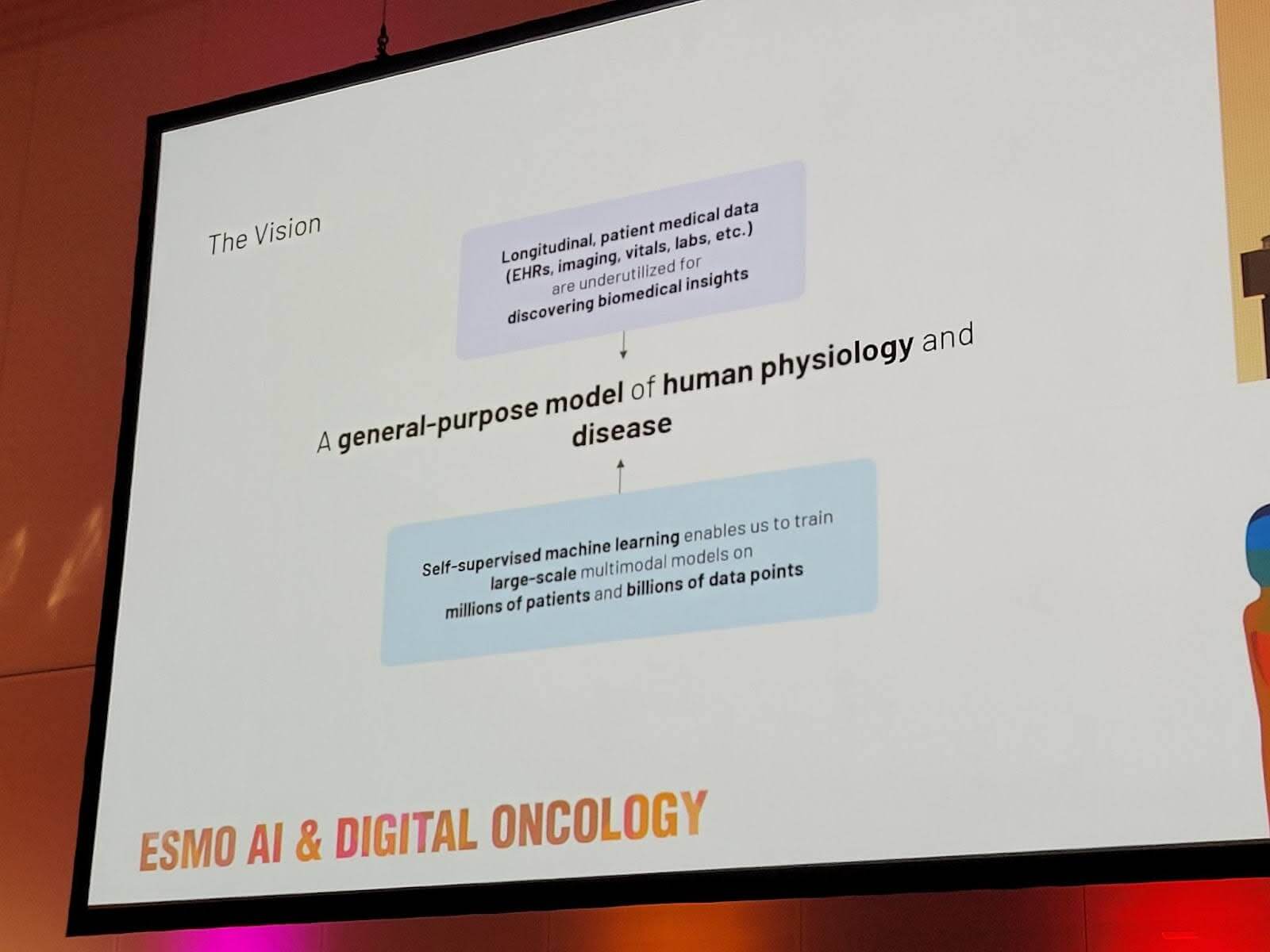The rise of agentic AI in cancer research: highlights from ESMO AI
Last week, the European Society for Medical Oncology (ESMO) hosted its first-ever congress dedicated entirely to artificial intelligence in cancer research. This represented a landmark moment for the field and, of course, we had to be there! While the event was more intimate than ESMO’s main annual congress, the scientific quality remained exceptional. In many ways, this event marked a historic moment in recognizing AI as an integral part of oncology research.
From Machine Learning to AI Agents

The meeting opened with a reminder of how rapidly this transformation has taken place. As Pr. Jakob Kather illustrated in his introductory session, AI in oncology has progressed through a remarkable evolution:
- 2000s: classical Machine Learning (ML) methods
- 2010s: single-purpose deep learning
- 2020: foundation models and self-supervision
- 2023: generalist models & Large Language Models (LLMs)
- 2025: AI Agents
This rapid acceleration underscored a central message of the congress: the oncology community must not only keep up with technological change but also shape it through guidelines, shared standards, and clinical validation. ESMO has already begun this work, having recently published guidance on the use of LLMs in oncology1 and currently developing a framework for AI-based biomarkers.2
Multimodal AI: towards comprehensive clinical decision-making
One of the recurring themes throughout the congress was multimodal AI: an approach that integrates multiple types of data, from histology and genomics to clinical records and imaging. While many AI models have historically focused on single modalities, the consensus was clear: future models must reflect the complexity of cancer biology to meaningfully support treatment decisions.
Several talks highlighted both the potential and the effort required to make multimodal AI work in practice. One concrete example came from the Horizon Europe-funded I3LUNG program, which aims to support immunotherapy decisions in non-small cell lung cancer.3 Despite being AI-driven from the start, the majority of the work went into building and harmonizing a large multimodal dataset - 36 months and more than 70 different experts. This underscores that data readiness remains one of the primary bottlenecks to AI in healthcare. Other sessions emphasized similar lessons across indications, showing that successful multimodal AI depends not only on sophisticated models but also on robust, curated, and well-integrated datasets.
Taken together, the talks reinforced a central message: the value of multimodal AI lies in its ability to produce clinically actionable insights, guide treatment decisions, and ultimately improve patient outcomes.
Clinical trials and the rise of agentic AI
AI’s rapidly growing impact on drug development and clinical research was another major focus of the conference. Presentations covered trial matching and pre-screening, AI-designed therapeutics, and risk prediction for operational success. Early results are promising: AI-designed drug candidates have already entered the clinic, with early-phase success rates that nearly double historical averages.
Realizing AI’s full potential still requires addressing practical considerations such as data access, bias, and regulatory alignment. Speakers highlighted the importance of integrating AI into clinical workflows and global infrastructures to ensure results are reliable, actionable, and accessible to all patients.
Looking ahead, the conference painted a vision of Agentic AI as the next frontier. Prof. Faisal Mahmood’s keynote as well as several other sessions held a glimpse of what the next decade may look like: foundation models trained across millions of patients and billions of data points; AI systems capable of reasoning across imaging, pathology, clinical text, and molecular data; and agents that act not just as tools but as “collaborative colleagues” in tumor boards, drug discovery, and trial optimization.

The vision is hybrid intelligence: AI that augments clinical judgment and is embedded in workflows.
At Owkin, this vision is embodied in K-Pro, our AI co-pilot built to reason through multimodal patient data. Powered by Owkin Zero4, a fine-tuned biological LLM for high-performance scientific reasoning, K-Pro provides natural-language access to integrated clinical, molecular, and spatial datasets. It enables researchers to accelerate target discovery, optimize trial design, and identify patient populations more effectively. In practice, tools like K-Pro bring to life the capabilities outlined throughout the conference: AI systems that combine reasoning, multimodal integration, and reproducibility to support real-world scientific decision-making.
Why this moment matters
Together, these discussions at ESMO AI signaled a profound shift in oncology: AI is moving from a supportive tool to an active partner. High-quality data, agentic AI, and human expertise are converging to create more informed, precise, and actionable decision-making. For its first edition, ESMO AI accomplished something remarkable. It brought together oncologists, AI researchers, and industry leaders into a shared conversation, acknowledging both the opportunities and the challenges of integrating AI into cancer research and care.
For Owkin, this reinforces our mission: to translate multimodal AI research into real-world clinical impact. Platforms like K-Pro exemplify how agentic AI can assist researchers in analyzing complex patient data, informing trial design, and ultimately supporting precision medicine in ways that are actionable and trustworthy.
Looking ahead
No one can fully anticipate the breakthroughs that will emerge before the next AI congress in Berlin in 2026, but after this first edition, one thing is certain: AI is no longer the future of oncology; it is the present.
The next era of cancer research will be driven by collaborative, multimodal, explainable, and clinically validated AI, and Owkin will continue to play a leading role in shaping it.
The revolution has begun. And this time, it’s not about hype... It’s about impact.
Citations
1 ESMO guidance on the use of Large Language Models in Clinical Practice (ELCAP) Wong, E.Y.T. et al.; Annals of Oncology
2 ESMO Basic Requirements for AI-based Biomarkers In Oncology (EBAI) Aldea, M. et al.; Annals of Oncology




